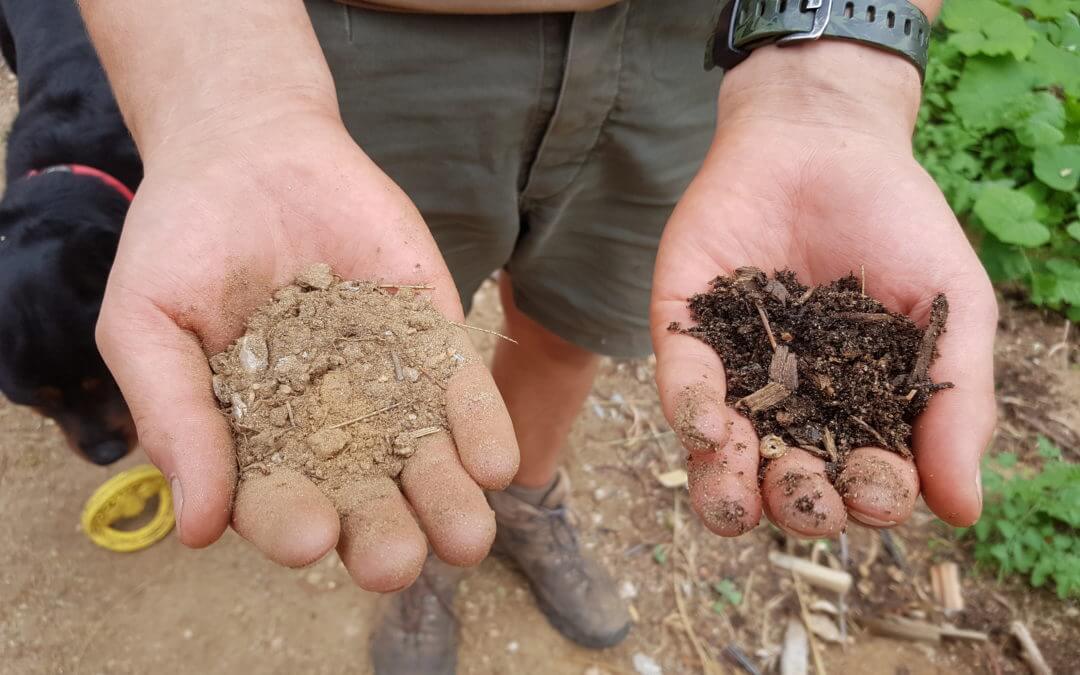“Never put a 1000 dollar plant in a 10 dollar hole!”
Last time we looked at soil types and how you can identify your soil easily at home. Sarah showed us that planting like crazy without preparing the soil first is probably not a good idea!
Sarah just did all her soil testing and now knows that her soil is very hard and filled with rocks! So, what can we do about it?
In this blog post you will learn more about soil amendments and how to use them to improve your Namibian soil, it’s drainage and nutrients!
Ah, and by the way, the picture below shows an experiment we did! We prepared a batch of the garden with some compost and organic material. As you can see – the plants DON’T grow outside that batch…it’s like they hit a wall!
Even the soil samples look completely different:


A quick overview of soil amendments:
There are literally hundreds of soil amendments out there – let me focus on some basic, organic ones every Namibian should know about:
Compost
Compost is a great way to add organic matter to your ground. When you have a heap of “unfinished” organic material and you water it regularly, microorganisms will start to decompose the organic matter. It does take some practice to make a good compost (I might write a post about that some time), but if you do it right you are left with an earthy smelling, pitch-black (not brown), rich mass. This is exactly the type of material you want in your garden!
Manure
Manure is a bit tricky! It is a great way to add organic matter to your soil. ESPECIALLY if you are on a tight budget. BUT the nitrogen contained in manure (especially horse and poultry manure) is the stuff that “burns” your plants. So don’t add it to your pot plants. Also, manure sometimes contains seeds or germs when fresh. So try to go with older manure (at least 6 months old) or consider using the manure to “fuel” your compost.
Fertilizer
Fertilizers can be seen as VERY strong composts – they are usually PACKED with nutrients. Unfortunately, most people use those chemical fertilizers (they say “organic” on the bag, but just by the smell you can tell this isn’t natural). With the bad fertilizers, the nutrients can be “washed” out of the ground by watering or you make your soil dependent on being “spoon-fed” by fertilizers. This is why we are so happy with vermicompost! Vermicompost the natural alternative to fertilizers and will make your soil very sustainable! It works great in addition to compost because it helps plants to use the nutrients of the compost. PLUS, it can easily be turned into a liquid fertilizer!
Coconut Coir and peat moss
Coconut Coir and peat moss are both very sponge-like materials. They are great to improve the texture of your soil and can usually be bought in every gardening store. I personally prefer using Coconut Coir because it is the more eco-friendly choice, but both will get the job done.
How to improve your soil type:
Soil can range from dry, dead sand, to very hard and rocky ground to a slick, clay-like mass
Fixing this is relatively easy! Just mix your soil with some of the other types of soil! So when you have sand in your garden, mix some clay or rocky ground into it! If you have a rocky ground – definitely add some sand!
Now we have the texture down, but the way I know Namibia the soil will still be pretty “dead” – no nutrients at all!
Often soil is low in organic matter, necessary for the structure, water retention and life of your soil. You can add organic matter by adding: compost, composted manure, old gardening offcuts like leaves and twigs. Additionally, you can add vermicompost – this will really help your soil, BUT if your soil does not have the right amount of organic material and the right texture yet, you will probably need to add A LOT of organic material, and vermicompost might be too expensive for those quantities. So rather see it as a good add-on and a great way to re-fertilize your soil regularly.
How to improve texture and drainage:
If you add enough compost and organic material your soil should already look more “rich” and feel more “fluffy” than before
In many cases, however, you will want to improve the texture of your soil even further. Coconut Coir and peat moss are probably the best ways to achieve this. Both of them can often be bought in “blocks”. You will see – they suck up A LOT of water and grow in volume – that’s exactly what we want for your soil!
In case you have a particularly rocky or clay-like type of soil, they will be able to make the soil more “fluffy”. And for people with sandy soil coconut Coir or peat moss will help retain water longer in your soil.
Congratulations!
You just turned into a garden-soil expert! You now know how to test your soil at home AND you know how to prepare your soil correctly.
Next time we will take a look at some tips and tricks to make your garden more organic and eco-friendly!


Recent Comments